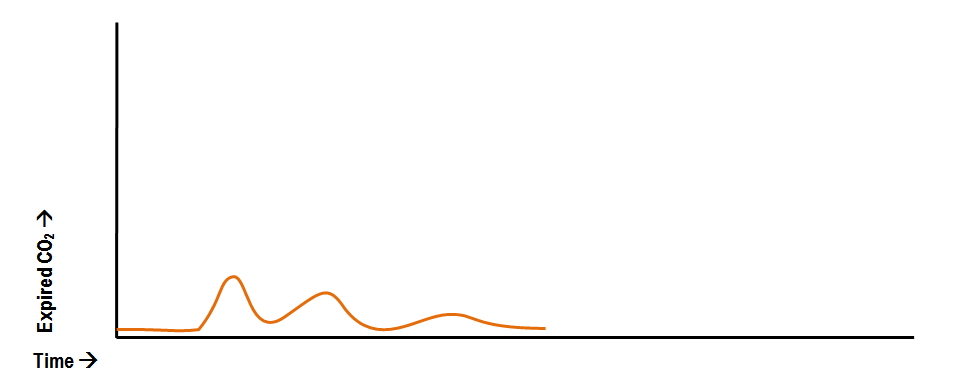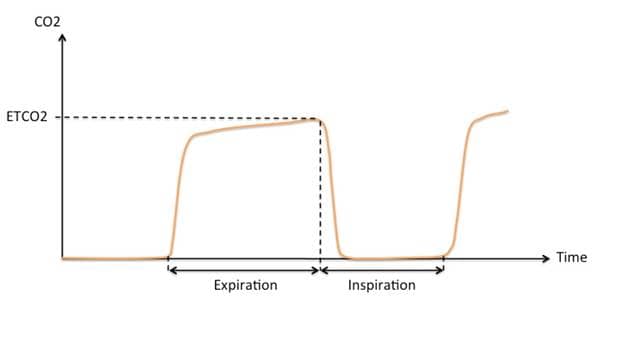normal end tidal co2 dog
Co 2 Physiology CO 2 is a waste product of normal aerobic cellular metabolism. Expiration 0 40 CO 2 g 20 60 Hypoventilation is characterized by higher than normal end-tidal CO 2 indicating respiratory depression and inefficient gas exchange.
The mean arterial pressure MAP is determined by the following equation.

. MmHg Relate to the air we breath. 78 Nitrogen 21 Oxygen 1 CO2 and other gases Exhaled gases. Capnography also measures and displays the respiratory rate.
The normal levels of expired CO2 in dogs and cats should between 35 and 45 mm Hg millimeters of mercury. According to the book by Hockenberry and Wilson 2015 p 1140 normal values of ETCO2 are 30-43 mmHg which is slightly lower than arterial PaCO2 35-45mmHg. The heart pumps the oxygenated blood to the cells where it is used for normal cellular metabolism.
The normal capnograph LVFKDUDFWHULHGE D³VTXDUH waveform that plateaus at 30 40 mmHg during expiration and returns to 0 mmHg during inspiration. In patients with normal pulmonary function CO 2 normally 35 to 45 mm Hg and ETco 2 should correlate closely with a deviation of about 2 to 5 mm Hg. Pulse pressure is a result of the difference between the systolic and diastolic pressures.
Normal range is 35-45mmHg and roughly correlates with the partial pressure of CO2 in arterial blood remember that PaCO2 is usually slightly higher than ETCO2 by 2-5mmHg. An end-tidal capnography waveform measures and displays the peak amount of CO2 at the end of exhalation. This is an important component of anesthesia because it helps the anesthetist evaluate the patients respiratory rate and also the quality of the respirations breaths.
Join us in this hour and learn about monitoring the patient undergoing anesthesia interpretation of end tidal carbon dioxide CO2 values and appropriate interventions for patients with abnormal values. The end-tidal level of carbon dioxide is generally less but is reflective of carbon dioxide in arterial blood and can serve as an indirect noninvasive method of assessing the adequacy ventilation. Reading the Waves When it comes to capnography everyone knows the normal adult respiratory.
Examples of some common capnograms are. Capnography is the measurement and evaluation of the levels of CO2 in a patients exhaled breath or the end-title CO2 ETCO2. Systole represents cardiac contraction and diastole occurs during cardiac filling.
Common narrow plateaus seen during. There is good correlation between ETCO2 and arterial CO2 in birds and mammals and capnography can be used as a reliable tool to evaluate the adequacy of ventilation in these species. Capnometry measures the maximum value of carbon dioxide CO2 obtained at the end of expiration or end-tidal carbon dioxide ETCO2.
Most anesthetics are respiratory depressants and end-tidal CO2 allows early detection of respiratory impairment so appropriate intervention can occur before the problem becomes life threatening. The end-tidal carbon dioxide tension PetCO2 measured after a single large tidal-volume breath 15 mlkg body weight was compared to simultaneous measurements of PaCO2 in 6 dogs with normal lungs who were receiving high-frequency jet ventilation HFJV. End-tidal carbon dioxide ETco 2 monitoring provides valuable information about CO 2 production and clearance ventilation.
Therefore better interpretation of the. The normal range for ETCO. 11172009 4 Measuring End Tidal CO2 Daltons Law.
A more complete picture of carbon dioxide transfer can be obtained from a capnogram similar to an ECG tracing. Anaesthesia of the dog Veterinary Anaesthesia Eleventh Edition 2014 Chapter 15 Pages 405-498. Circulating blood CO 2 is slightly greater than exhaled CO 2 due to a ventilation-perfusion VQ mismatch.
This is end-tidal CO 2 ETCO 2 which is normally 35 to 45 mm Hg in dogs and 28 to 32 mm Hg in cats. The optimal cutoff PetCO 2 was 18 mm Hg 24 kPa with a sensitivity of 80 and a specificity of 95 at minutes 3 4 5 6 and 8 correctly classifying 91-100 of cases. Variants of normal ETCO2 tracings from normal anesthetized animals.
We know that elevated ETCO2 hypercapnia occurs during hypoventilation and a decrease in ETCO2 hypocapnia occurs with hyperventilation. Oxygen O 2 is inhaled via the lungs where it diffuses across the alveolar-capillary membrane and enters the pulmonary circulation. Normal arterial blood pressure values for dogs and cats are indicated in Table 111.
Carbon dioxide during ventilation. Yes the generic normal is considered 35-45. There was an excellent linear correlation b.
Total pressure of a gas is the sum of the partial pressures of the gas Expired CO2 measured PetCO2 mmHg in waveform Percentage Normal Levels PaO2 85-100mmHg PaCO2 35-45mmHg Percentage vs. Capnography can be used to measure end-tidal CO 2. The capnograph is the waveform that shows how much CO 2 is present at each phase of the respiratory cycle and it normally has a rectangular shape Figure 1.
Riding The Wave Of Capnography Understanding Etco2 Vetbloom Blog

Avma 2017 Anesthesia Monitoring With Capnography Surgical Nursing Anesthesia Monitor

Pdf Capnography In Dogs Semantic Scholar

Capybaras Are Very Vocal And They Can Make Dog Like Barks They Are Herbivores And Chew Food By Grinding Back And Forth Rather Than S Capybara Herbivores Dogs

Mapping The Flow Of Textiles In The Central Region Of Denmark Sankey Diagram Circular Economy Central Region

Abnormal Capnography Waveforms And Their Interpretation Deranged Physiology
Riding The Wave Of Capnography Understanding Etco2 Vetbloom Blog

Avma 2017 Anesthesia Monitoring With Capnography Surgical Nursing Anesthesia Monitor

Pdf Capnography In Dogs Semantic Scholar



